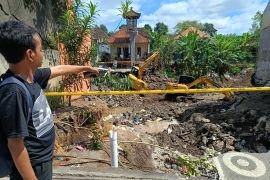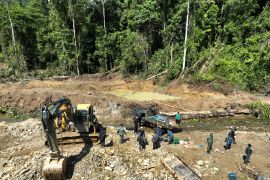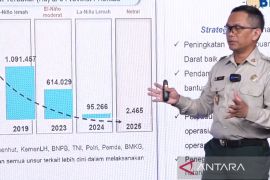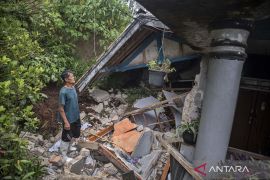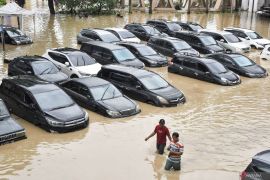Last year, during the January-mid December period, a total of 2,427 natural disasters hit the country, leaving at least 4,821 people dead or missing, according to the National Disaster Mitigation Agency (BNPB).
Of the total, 2,350, or 96.9 percent of the natural disasters, were hydrometeorological disasters such as floods, landslides, and whirlwind, while 76, or 3.1 percent, were geological disasters.
In West Java alone, a total of 1,561 natural disasters hit the province, killing 50 people and affecting 75,706 residents.
Currently, Indonesia is experiencing peak rainy season across the nation, and therefore, the Meteorology, Climatology, and Geophysics Agency (BMKG) has warned of possible hydrometeorological disasters.
The agency called on the people to remain vigilant, as Indonesia was currently experiencing the peak of the rainy season, Mulyono Rahadi Prabowo, the BMKG`s deputy in charge of meteorology, noted in a statement, on Jan 17, 2019.
The condition in the Indian Ocean and the direction of wind indicated possible heavy rains, lightening, thunder, and strong wind, he remarked.
The agency has also forecast sea waves, reaching heights of between 2.5 meters and 4 meters, among others things, in the waters of Mentawai, Bengkulu, Enggano, Lampung, Indian Ocean, Sunda Strait, southern Java, Sumbawa, Bali Strait, Lombok, southern Alas, North Natuna, Kepupy Anambas, Makassar Strait, Flores Sea, Banda Sea, Sangihe, Halmahera, Biak, and northern Pacific Ocean.
Flooding and whirlwind hit several provinces lately, including Lampung, West Java, Aceh, and West Sumatra.
Following the warning, Speaker of the Indonesian House of Representatives (DPR RI) Bambang Soesatyo has called for vigilance against possible natural disasters.
Every district and city administration must consolidate and coordinate its disaster mitigation office (BPBD) to anticipate natural disasters, he stated recently.
"Every regional head whose region is prone to natural disaster must remain vigilant and cautious. Every element in BPBD must begin consolidation and anticipation," he added.
He urged anticipatory measures following a series of earthquakes in Banda, Bengkulu, East Nusa Tenggara (NTT), and the Sunda Strait on Jan 10 and 11, 2019.
Besides earthquakes, several volcanoes have been erupting, such as Mount Anak Krakatau in the Sunda Strait, Mount Agung in Bali, Mount Merapi in Yogyakarta, and Mount Ibu in North Maluku.
The recent earthquakes and volcano eruptions so far did not pose serious threats, but the House Speaker asked the local governments to remain vigilant and prepared.
Moreover, the Meteorology, Climatology and Geophysics Agency (BMKG) has warned that there is a potential tsunami in the Sunda Strait, following the deadly volcanic tsunami triggered by Mount Krakatau that killed nearly 450 people in Banten and Lampung Provinces, on Dec 22, 2018.
The local disaster mitigation officers must actively communicate with BMKG officers to minimize the number of victims of natural disasters such as floods, landslides, earthquakes, and volcano eruptions, he explained.
To help the public at large to be prepared, the BNPB has launched a public campaign on the use of InaRISK Personal Application which offers real-time data and information on potential disasters.
The application, downloadable on smartphones, will enable users to get precise information on where they stand and what types of threats they would likely face, the agency`s spokesman, Sutopo Purwo Nugroho, noted.
Nugroho cited the example of Cimapag Hamlet in Sinaresmi Village, Cisolok Sub-district, Sukabumi District, West Java Province, wherein the InaRISK Personal Application mapped the area ripped off by a deadly landslide on Dec 31, 2018.
Certain parts of the hamlet were buried by the landslide that killed 32 people and rendered one village missing.
He admitted to not many people being aware of this InaRISK Personal Application due to lack of promotion and public campaign.
Although the InaRISK Personal Application is easily used, its usability still relies on the network coverage of cellular phone service providers, so it might not work well for producing real-time data in blank spot areas, he noted.
In addition to using the information technology, the government believes that disaster mitigation should be taught in school.
Education and Culture Minister, Muhadjir Effendy has revealed that character education will include material on student resilience to disasters as Indonesia is vulnerable to natural disasters.
Some materials to be included in character education will be the dangers of drugs, safe schools, dangerous thoughts, traffic law awareness, anti-corruption, and disaster mitigation, among other things.
A senior researcher of the Environmental Affairs and Forestry Ministry, however, suggested that disaster mitigation education should be part of the environmental lesson at schools since disaster and the environment are closely related.
"It will be very appropriate to include tsunami disaster mitigation education in an environmental lesson. It is a synergy and inseparable," Hendra Gunawan, chief researcher of the Environmental Affairs and Forestry Ministry, stated on Jan 17, 2019.
A disaster could be triggered by environmental damage or men, he remarked.
Meanwhile, the Indonesian government has agreed to allocate Rp15 trillion in budget fund for disaster anticipation and mitigation in the 2019 state budget.
"Last year, we spent more than Rp7 trillion (on disaster mitigation). The budget fund did not merely go to the BNPB (National Disaster Mitigation Board). We increased the expenditure in the form of on-call fund," Finance Minister Sri Mulyani Indrawati stated recently, after a plenary cabinet meeting themed "Programs and Activities in 2019" at the State Palace
She noted that the on-call fund will be made available if the BNPB deems it necessary to take emergency action.
Besides, the government begins to prepare disaster insurance mechanism by setting aside Rp1 trillion worth of pooling fund to speed up the recovery of the affected areas.
The fund can be disbursed by taking into account the extent of natural disasters, including the number of victims and the amount of material losses.
Reporter: Fardah Assegaf
Editor: Fardah Assegaf
Copyright © ANTARA 2019


